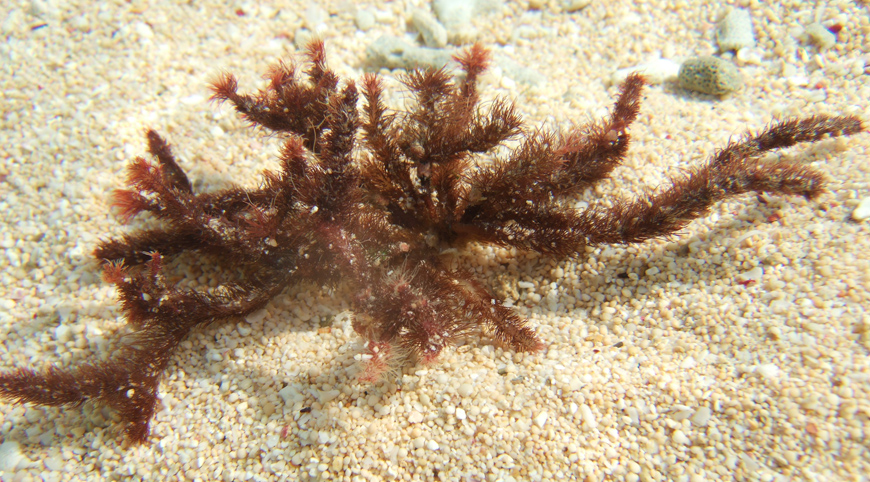Global S&T Development Trend Analysis Platform of Resources and Environment
| Research Highlight: Scientists Develop New Production Method for Seaweed Chemical Used in Brain Research | |
| admin | |
| 2019-05-01 | |
| 发布年 | 2019 |
| 语种 | 英语 |
| 国家 | 美国 |
| 领域 | 资源环境 |
| 正文(英文) |  The seaweed Digenea simplex on the beach. Photo: Toshiaki Teruya/University of Ryukyus, Japan A team of scientists at Scripps Institution of Oceanography at the University of California San Diego and the J. Craig Venter Institute (JCVI) has developed a new way to produce kainic acid, a natural seaweed neurochemical and powerful reagent used in brain research. In a new study published April 17 in the journal Angewandte Chemie International Edition, the scientists were able to sequence the genome of a seaweed known to produce kainic acid, and they identified the enzymes responsible for production of the natural chemical. They also utilized biotechnology to develop a cheaper and more efficient way to produce the seaweed chemical in gram quantities in the lab—a major breakthrough with implications for large-scale production of kainic acid in the future. “Because kainic acid is an important molecule still used in research today, we wanted to develop a new way to produce it,” said lead author Jonathan Chekan, a postdoctoral fellow at the Center for Marine Biotechnology and Biomedicine at Scripps Oceanography. “This biotransformation approach allows us to quickly produce kainic acid in a cheaper and more environmentally friendly way than traditional chemical synthesis.” Kainic acid is found in certain types of red algae, or seaweed, around the world. Centuries ago, people in Japan discovered that eating a local seaweed known as Digenea simplex could treat parasitic worm infections. In the 1950s, scientists identified kainic acid as the active compound in D. simplex seaweed, leading to its clinical use as an anti-parasitic drug in Japan. Kainic acid activates excitatory glutamate receptors that control cell-to-cell communication in the brain and are critical for short-term memory. In recent years, kainic acid has been used as a research tool to study human neurological conditions such as epilepsy and Alzheimer’s disease. Worldwide shortages of the seaweed natural product in 2000 prompted researchers to use chemical synthetic versions of kainic acid. While more than 70 synthetic versions exist, they require a minimum of six steps to produce, have a low production rate, and are very expensive. These factors have limited many scientists from using kainic acid for research. The new kainic acid production method described by the authors could open the door for large-scale biotechnological production of the chemical. Their research builds upon the team’s recent work on discovering the genetic origin of domoic acid, a potent neurotoxin produced by planktonic microalgae. The domoic acid study helped the scientists develop a hypothesis for how a chemical compound like kainic acid is formed within a living organism—in this case seaweed—in a process known as biosynthesis. “Our work represents the first example of a validated cluster of genes that code for the production of a seaweed natural product drug. This knowledge has enabled a new and more affordable supply of kainic acid for researchers studying human neurological diseases,” said senior author Bradley Moore, a professor at Scripps Oceanography and the Skaggs School of Pharmacy and Pharmaceutical Sciences at UC San Diego. The researchers began the study by sequencing the genomes of two kainic acid producing seaweeds, D. simplex and Palmaria palmata, for the first time ever. Very few seaweed genomes have been sequenced due to the high repeat nature of algal genomes, the relative unknown sizes of seaweed genomes, and the technical challenges in obtaining seaweed samples free of contaminating microbes and other algae. - Brittany Hook |
| URL | 查看原文 |
| 来源平台 | Scripps Institution of Oceanography |
| 文献类型 | 新闻 |
| 条目标识符 | http://119.78.100.173/C666/handle/2XK7JSWQ/128946 |
| 专题 | 资源环境科学 |
| 推荐引用方式 GB/T 7714 | admin. Research Highlight: Scientists Develop New Production Method for Seaweed Chemical Used in Brain Research. 2019. |
| 条目包含的文件 | 条目无相关文件。 | |||||
| 个性服务 |
| 推荐该条目 |
| 保存到收藏夹 |
| 查看访问统计 |
| 导出为Endnote文件 |
| 谷歌学术 |
| 谷歌学术中相似的文章 |
| [admin]的文章 |
| 百度学术 |
| 百度学术中相似的文章 |
| [admin]的文章 |
| 必应学术 |
| 必应学术中相似的文章 |
| [admin]的文章 |
| 相关权益政策 |
| 暂无数据 |
| 收藏/分享 |
除非特别说明,本系统中所有内容都受版权保护,并保留所有权利。
修改评论